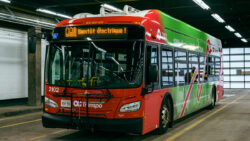OC Transpo is 19 buses short ahead of a slew of route changes planned under the New Ways to Bus, which comes into effect April 27.
A minimum of 540 buses a day are needed while OC Transpo has an average of 521 buses available, city staff told transit committee April 10.
While incoming route changes require fewer buses, with more passengers being moved over to the train, councillors remain concerned about whether OC Transpo has the resources to resume full service in September after reduced summer service.
“The margin is razor thin for being able to deliver service in September. I’m not hearing anything today that gives me confidence that we are going to be able to procure the buses that will give us the margin,” said Kitchissippi Coun. Jeff Leiper.
Bus numbers are dwindling because of OC Transpo’s aging bus fleet. Eighteen were retired this past winter and every articulated bus in the OC Transpo fleet will have surpassed its 15-year lifespan and will “officially be due for retirement by this time next year,” said Rami El Feghali, director of transit bus operations and maintenance.
“By extending the lives of our buses past their expected end of life, we drastically increase workload to maintain the set standard for buses to be in service each day,” El Feghali said. “Not only do we find an increase in the quantity of defects during our maintenance inspections, but the defects that are found also increase in severity.”
There are 735 buses in the active fleet, but 39 buses require major repairs taking 30 or more days, 24 buses are in inspections and 120 buses require work for daily defects, according to data presented by OC Transpo staff.
An average of 150 buses were out of commission each day of the winter. El Feghali said winter maintenance focused on quick-turnaround repairs to maximize the number of buses on the roads, while major repairs continued to accumulate.
OC Transpo is also short 50 mechanics, causing further maintenance delays.
Younger Nova buses introduced to the fleet in 2019 are taking on increased workloads to compensate for the aging fleet. These buses are driving an additional 18,550 kilometres a year and accumulating a 20 per cent increase in maintenance hours, according to data presented during the meeting.
Barrhaven East Coun. Wilson Lo emphasized the need for a long-term strategy to address the additional strain on the newer buses and the potential impacts of overuse.
“Perhaps we’ll need to replace our Nova buses when they turn 15 instead of 18,” Lo said. “I hope there’s a long-term plan to ensure that our situation now doesn’t get repeated.”
About 18 E-buses are part of OC Transpo’s fleet, with seven more in the commissioning process. Each time another E-bus is integrated into the rotation, an older, diesel bus will be pulled out of service.
“We will continue to maintain the aging fleet and fingers crossed we will not need to retire some of them prior (to) receiving E-buses,” said OC Transpo General Manager Renée Amilcar.
OC Transpo is also planning to buy an additional 50 diesel buses by 2027.
Following delivery delays caused by issues with the passenger seat supplier, OC Transpo is expected to receive 26 new E-buses by the end of the month, with 31 more anticipated by the end of the year. The long-term goal is to have a fleet of 354 E-buses by the end of 2027.
Amid an expanding fleet, concerns about reliability continue to plague OC Transpo. Regularity for frequent routes averaged 82 per cent over the last year, while punctuality for less frequent routes averaged 74 per cent. The numbers fall below the 85 per cent target for these on-time performance measures.
River Coun. Riley Brockington introduced a motion to direct OC Transpo to establish a detailed plan by October, 2025, on how these reliability measures can be met by December 2027.
“It’s time for a plan — how will we get to 85 per cent?” Brockington said. “Our passengers have been asking for years, and the committee has been asking. We will never retain passengers with an unreliable service.”
Some methods of increasing reliability will be easy, he said, including amending schedules at bus stops to give buses more time. Others, he added, may involve major capital improvements to intersections and bus corridors.
“We have a target, but we don’t have a timeline to achieve that target,” Brockington said. “What I expect the report to see is, here are all the ingredients or all the variables we could implement to get us to that 85 per cent.”
The motion was carried, and OC Transpo is now expected to present the plan to the transit committee in October.




